2010 FORD SUPER DUTY instrument cluster
[x] Cancel search: instrument clusterPage 1 of 104
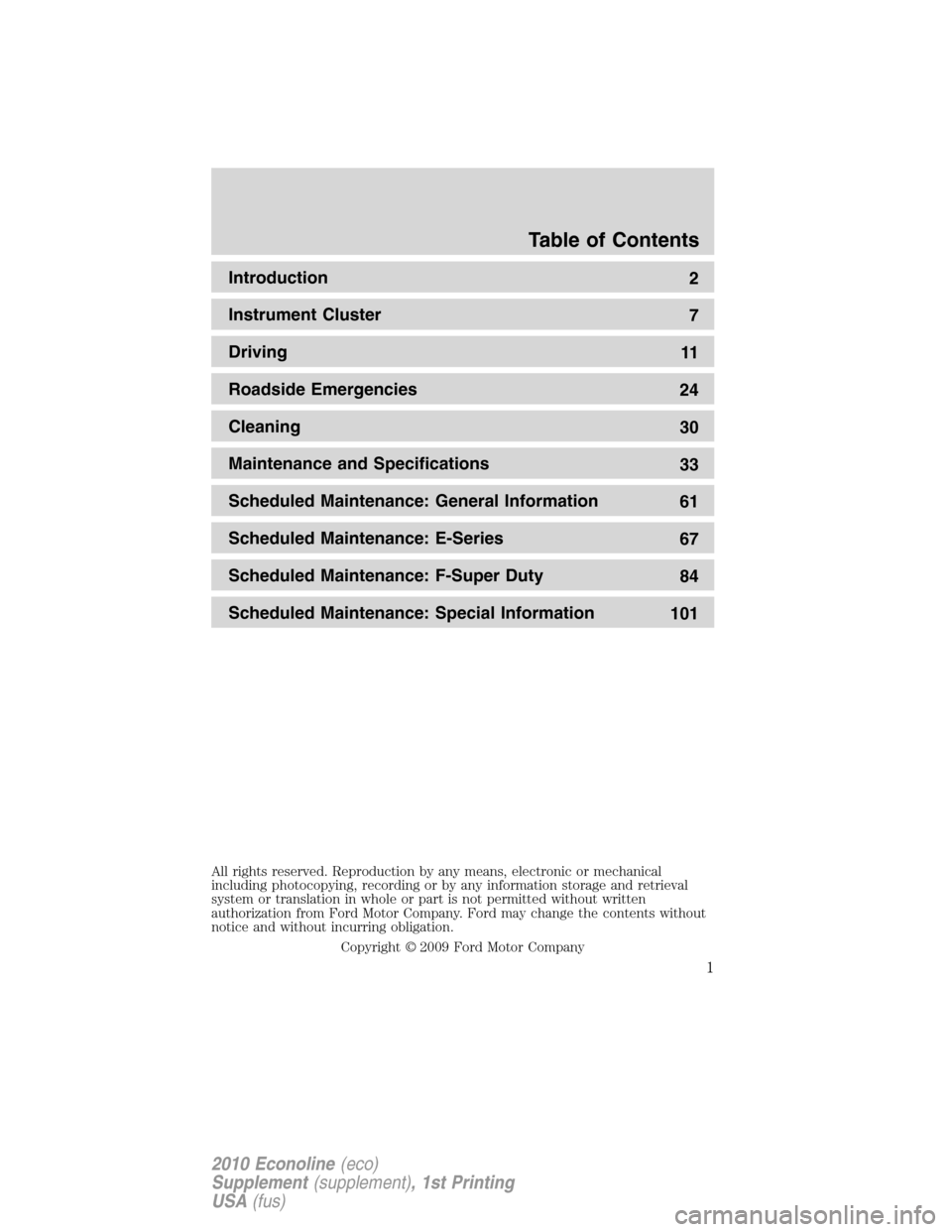
Introduction
2
Instrument Cluster
7
Driving
11
Roadside Emergencies
24
Cleaning
30
Maintenance and Specifications
33
Scheduled Maintenance: General Information
61
Scheduled Maintenance: E-Series
67
Scheduled Maintenance: F-Super Duty
84
Scheduled Maintenance: Special Information
101
All rights reserved. Reproduction by any means, electronic or mechanical
including photocopying, recording or by any information storage and retrieval
system or translation in whole or part is not permitted without written
authorization from Ford Motor Company. Ford may change the contents without
notice and without incurring obligation.
Copyright © 2009 Ford Motor Company
Table of Contents
1
2010 Econoline(eco)
Supplement(supplement), 1st Printing
USA(fus)
Page 4 of 104
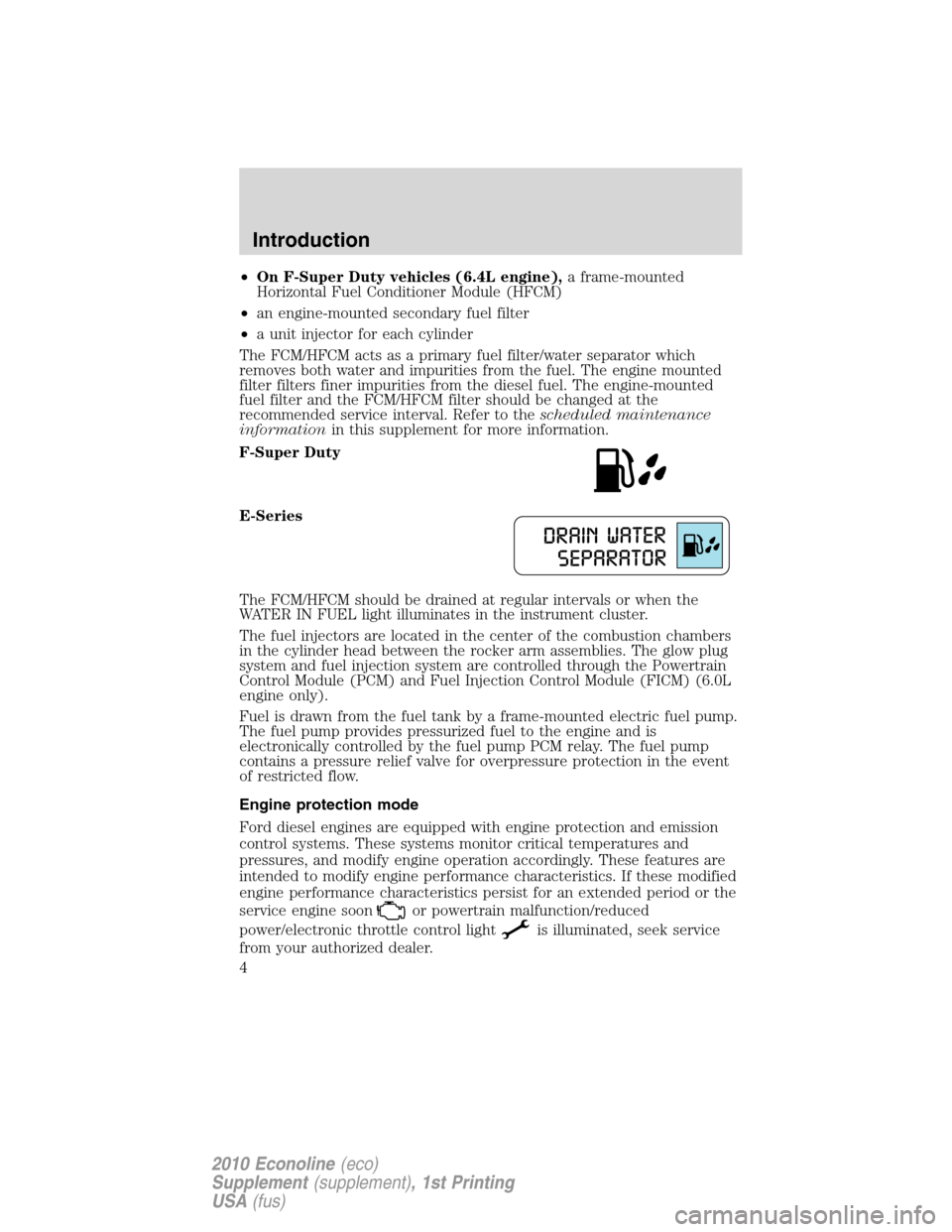
•On F-Super Duty vehicles (6.4L engine),a frame-mounted
Horizontal Fuel Conditioner Module (HFCM)
•an engine-mounted secondary fuel filter
•a unit injector for each cylinder
The FCM/HFCM acts as a primary fuel filter/water separator which
removes both water and impurities from the fuel. The engine mounted
filter filters finer impurities from the diesel fuel. The engine-mounted
fuel filter and the FCM/HFCM filter should be changed at the
recommended service interval. Refer to thescheduled maintenance
informationin this supplement for more information.
F-Super Duty
E-Series
The FCM/HFCM should be drained at regular intervals or when the
WATER IN FUEL light illuminates in the instrument cluster.
The fuel injectors are located in the center of the combustion chambers
in the cylinder head between the rocker arm assemblies. The glow plug
system and fuel injection system are controlled through the Powertrain
Control Module (PCM) and Fuel Injection Control Module (FICM) (6.0L
engine only).
Fuel is drawn from the fuel tank by a frame-mounted electric fuel pump.
The fuel pump provides pressurized fuel to the engine and is
electronically controlled by the fuel pump PCM relay. The fuel pump
contains a pressure relief valve for overpressure protection in the event
of restricted flow.
Engine protection mode
Ford diesel engines are equipped with engine protection and emission
control systems. These systems monitor critical temperatures and
pressures, and modify engine operation accordingly. These features are
intended to modify engine performance characteristics. If these modified
engine performance characteristics persist for an extended period or the
service engine soon
or powertrain malfunction/reduced
power/electronic throttle control light
is illuminated, seek service
from your authorized dealer.
Introduction
4
2010 Econoline(eco)
Supplement(supplement), 1st Printing
USA(fus)
Page 7 of 104
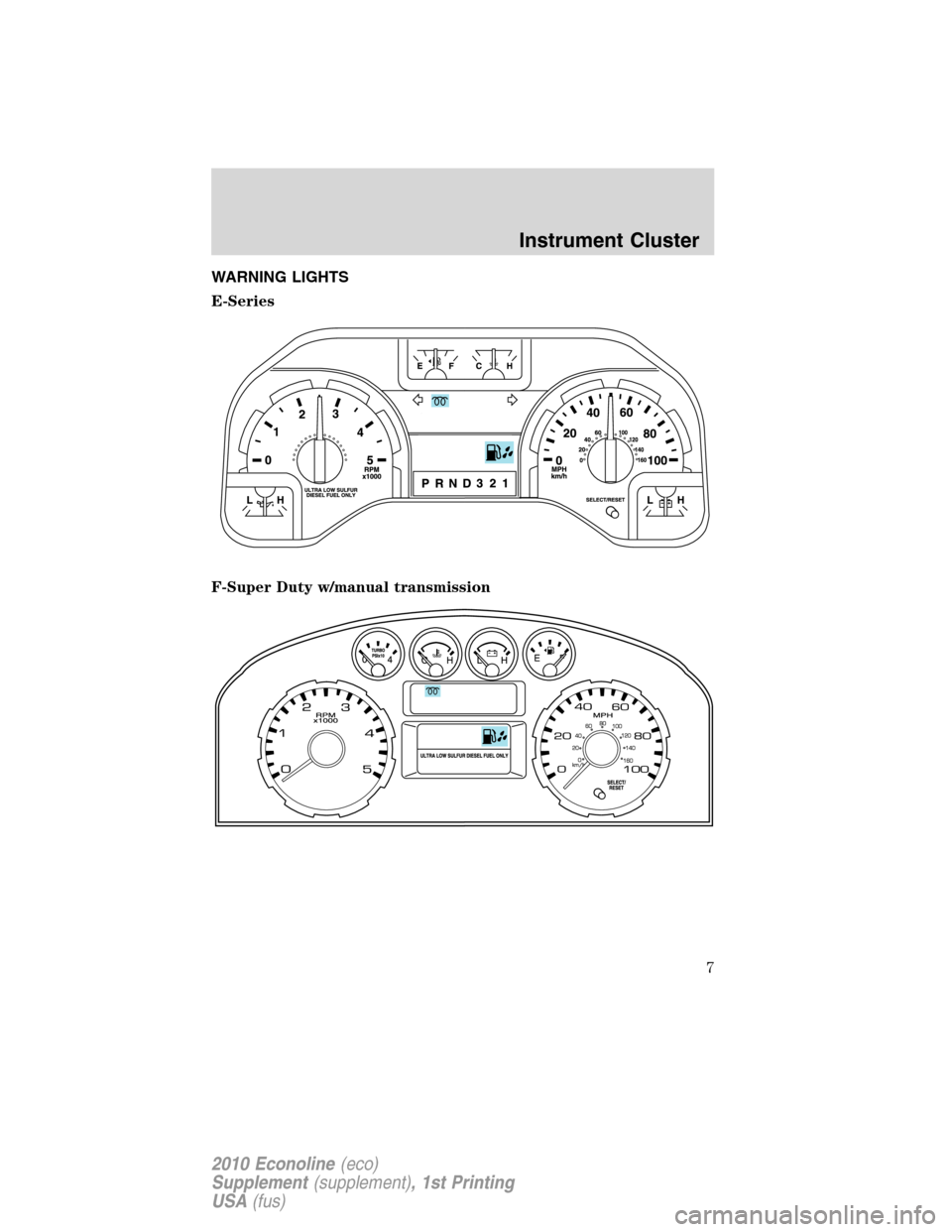
WARNING LIGHTS
E-Series
F-Super Duty w/manual transmission
Instrument Cluster
7
2010 Econoline(eco)
Supplement(supplement), 1st Printing
USA(fus)
Page 8 of 104
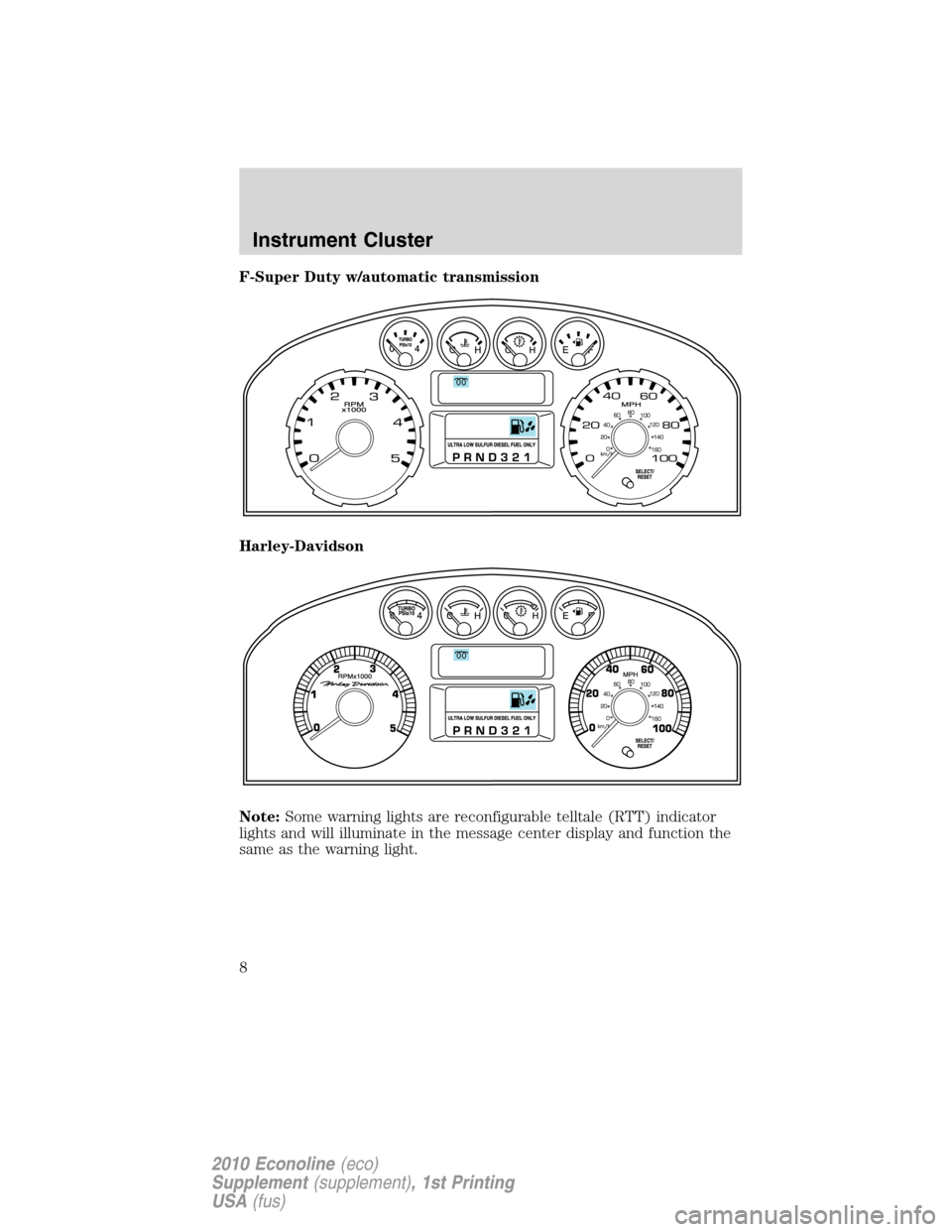
F-Super Duty w/automatic transmission
Harley-Davidson
Note:Some warning lights are reconfigurable telltale (RTT) indicator
lights and will illuminate in the message center display and function the
same as the warning light.
Instrument Cluster
8
2010 Econoline(eco)
Supplement(supplement), 1st Printing
USA(fus)
Page 9 of 104

Glow plug pre-heat indicator:
With the key in the on position,
the
light will illuminate if glow
plug heat is necessary as a starting aid. Wait until the light goes off
before starting. Refer toCold weather startingin theDrivingchapter
of this supplement. After the engine starts, the light should turn on. The
light should always illuminate at least momentarily when the engine is
cold and the ignition is turned to on. If it does not illuminate, the glow
plug system should be checked and repaired promptly to avoid difficulty
in cold starting.
Water in fuel:
F-Super Duty
E-Series
During refueling, it is possible for water-contaminated diesel fuel to be
pumped into your tank. Your vehicle’s fuel system is equipped with a fuel
filter/water separator to remove water from the fuel. The water in fuel
light will illuminate when the FCM/HFCM has a significant quantity of
water in it.
If the light illuminates when the engine is running, stop the vehicle as
soon as safely possible, shut off the engine, then drain the FCM/HFCM.
Refer toDraining the FCM/HFCM and changing the fuel filtersin the
Maintenance and Specificationschapter of this supplement for the
drain procedure. Allowing water to stay in the system could result in
extensive damage to, or failure of, the fuel injection system.
WARNING:Do not drain the water separator while the engine is
running. Fuel may ignite if the separator is drained while the
engine is running or the vehicle is moving.
Instrument Cluster
9
2010 Econoline(eco)
Supplement(supplement), 1st Printing
USA(fus)
Page 10 of 104
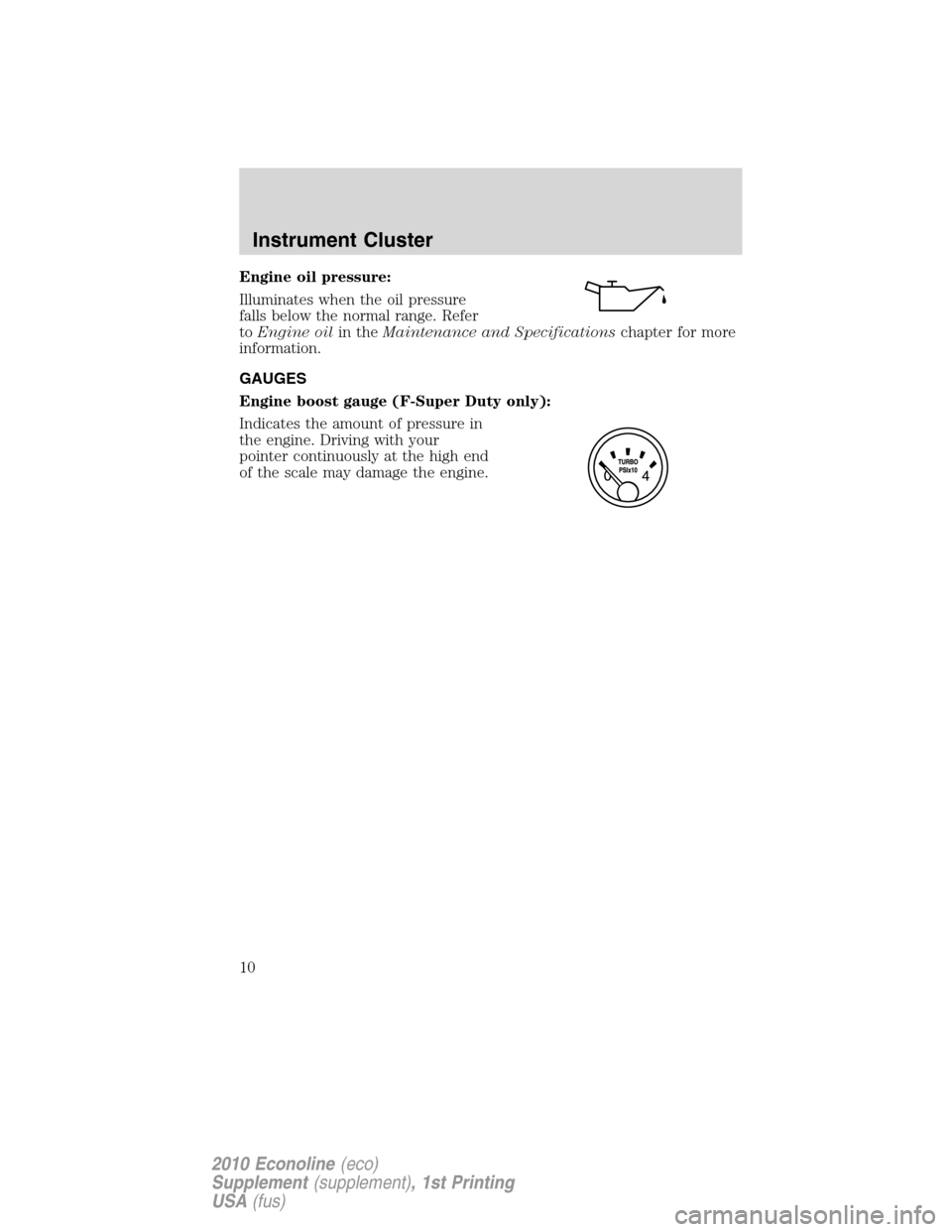
Engine oil pressure:
Illuminates when the oil pressure
falls below the normal range. Refer
toEngine oilin theMaintenance and Specificationschapter for more
information.
GAUGES
Engine boost gauge (F-Super Duty only):
Indicates the amount of pressure in
the engine. Driving with your
pointer continuously at the high end
of the scale may damage the engine.
Instrument Cluster
10
2010 Econoline(eco)
Supplement(supplement), 1st Printing
USA(fus)
Page 48 of 104
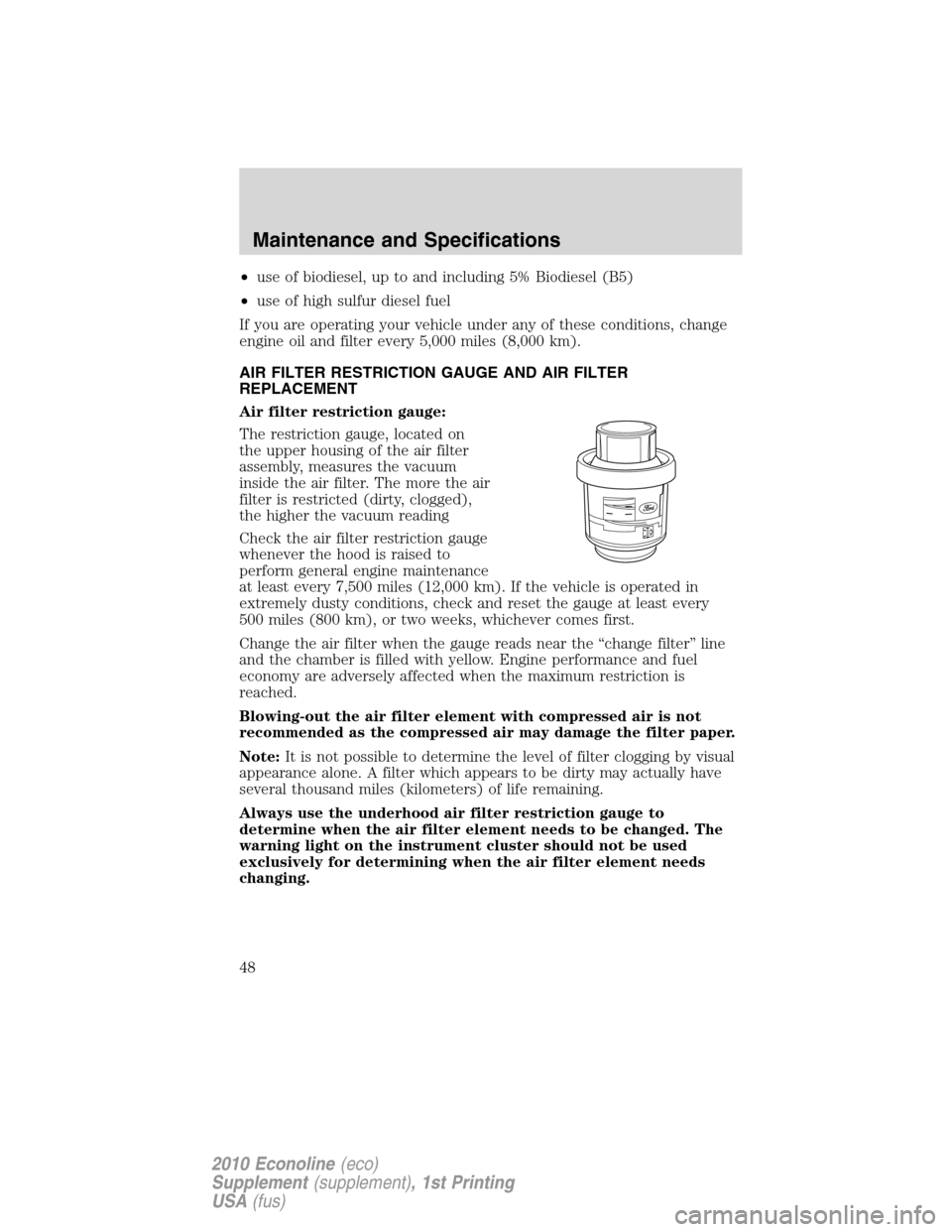
•use of biodiesel, up to and including 5% Biodiesel (B5)
•use of high sulfur diesel fuel
If you are operating your vehicle under any of these conditions, change
engine oil and filter every 5,000 miles (8,000 km).
AIR FILTER RESTRICTION GAUGE AND AIR FILTER
REPLACEMENT
Air filter restriction gauge:
The restriction gauge, located on
the upper housing of the air filter
assembly, measures the vacuum
inside the air filter. The more the air
filter is restricted (dirty, clogged),
the higher the vacuum reading
Check the air filter restriction gauge
whenever the hood is raised to
perform general engine maintenance
at least every 7,500 miles (12,000 km). If the vehicle is operated in
extremely dusty conditions, check and reset the gauge at least every
500 miles (800 km), or two weeks, whichever comes first.
Change the air filter when the gauge reads near the “change filter” line
and the chamber is filled with yellow. Engine performance and fuel
economy are adversely affected when the maximum restriction is
reached.
Blowing-out the air filter element with compressed air is not
recommended as the compressed air may damage the filter paper.
Note:It is not possible to determine the level of filter clogging by visual
appearance alone. A filter which appears to be dirty may actually have
several thousand miles (kilometers) of life remaining.
Always use the underhood air filter restriction gauge to
determine when the air filter element needs to be changed. The
warning light on the instrument cluster should not be used
exclusively for determining when the air filter element needs
changing.
Maintenance and Specifications
48
2010 Econoline(eco)
Supplement(supplement), 1st Printing
USA(fus)
Page 52 of 104
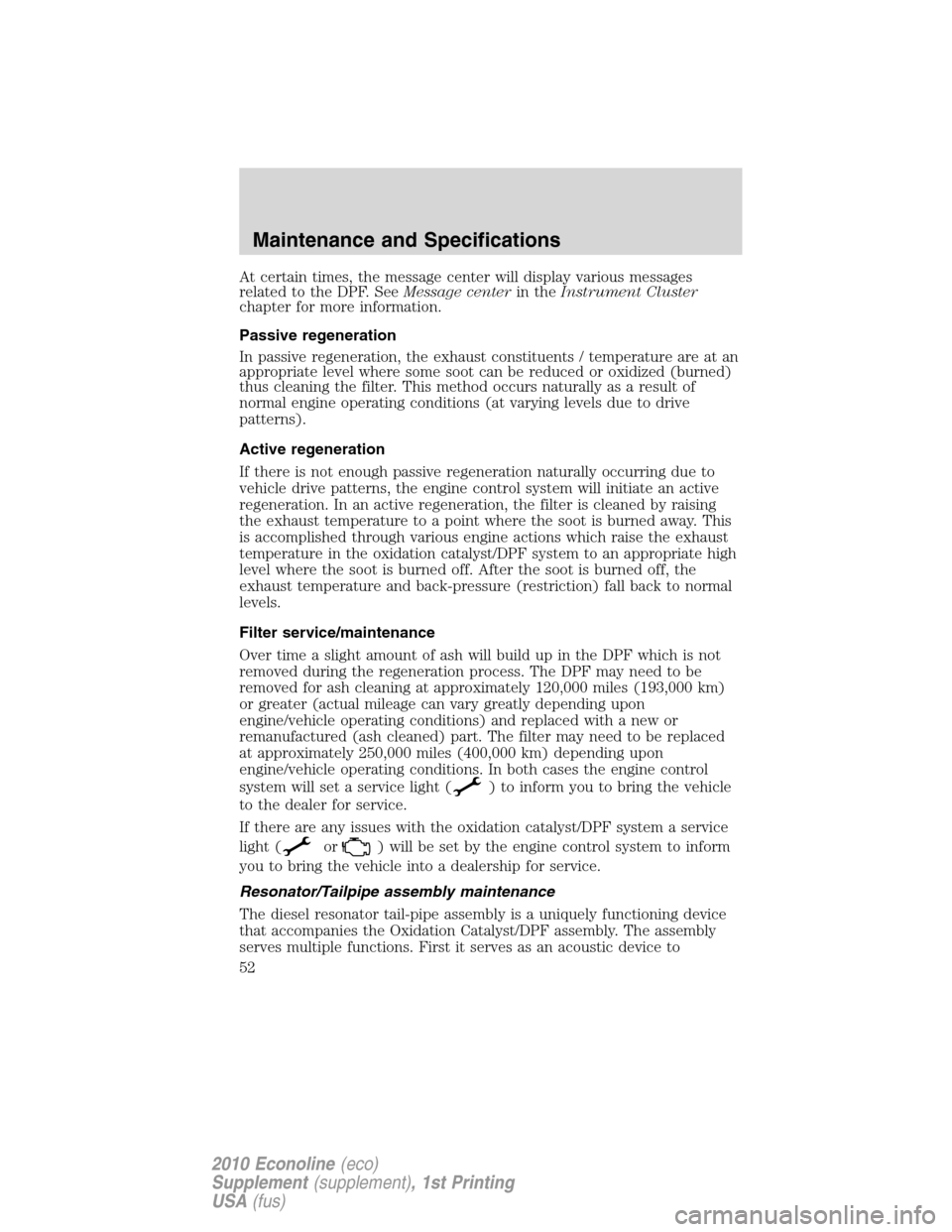
At certain times, the message center will display various messages
related to the DPF. SeeMessage centerin theInstrument Cluster
chapter for more information.
Passive regeneration
In passive regeneration, the exhaust constituents / temperature are at an
appropriate level where some soot can be reduced or oxidized (burned)
thus cleaning the filter. This method occurs naturally as a result of
normal engine operating conditions (at varying levels due to drive
patterns).
Active regeneration
If there is not enough passive regeneration naturally occurring due to
vehicle drive patterns, the engine control system will initiate an active
regeneration. In an active regeneration, the filter is cleaned by raising
the exhaust temperature to a point where the soot is burned away. This
is accomplished through various engine actions which raise the exhaust
temperature in the oxidation catalyst/DPF system to an appropriate high
level where the soot is burned off. After the soot is burned off, the
exhaust temperature and back-pressure (restriction) fall back to normal
levels.
Filter service/maintenance
Over time a slight amount of ash will build up in the DPF which is not
removed during the regeneration process. The DPF may need to be
removed for ash cleaning at approximately 120,000 miles (193,000 km)
or greater (actual mileage can vary greatly depending upon
engine/vehicle operating conditions) and replaced with a new or
remanufactured (ash cleaned) part. The filter may need to be replaced
at approximately 250,000 miles (400,000 km) depending upon
engine/vehicle operating conditions. In both cases the engine control
system will set a service light (
) to inform you to bring the vehicle
to the dealer for service.
If there are any issues with the oxidation catalyst/DPF system a service
light (
or) will be set by the engine control system to inform
you to bring the vehicle into a dealership for service.
Resonator/Tailpipe assembly maintenance
The diesel resonator tail-pipe assembly is a uniquely functioning device
that accompanies the Oxidation Catalyst/DPF assembly. The assembly
serves multiple functions. First it serves as an acoustic device to
Maintenance and Specifications
52
2010 Econoline(eco)
Supplement(supplement), 1st Printing
USA(fus)